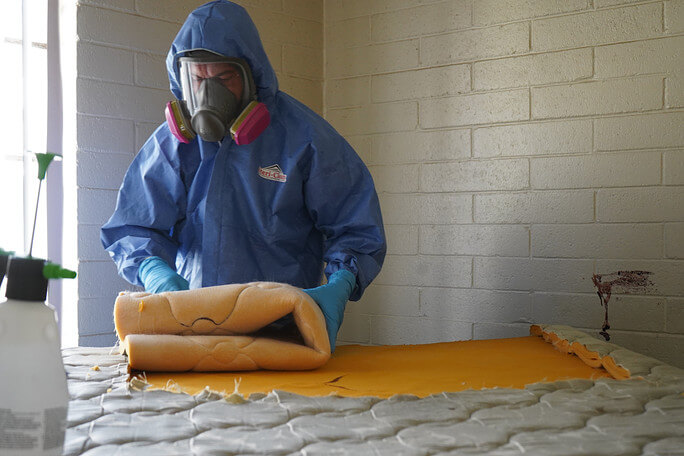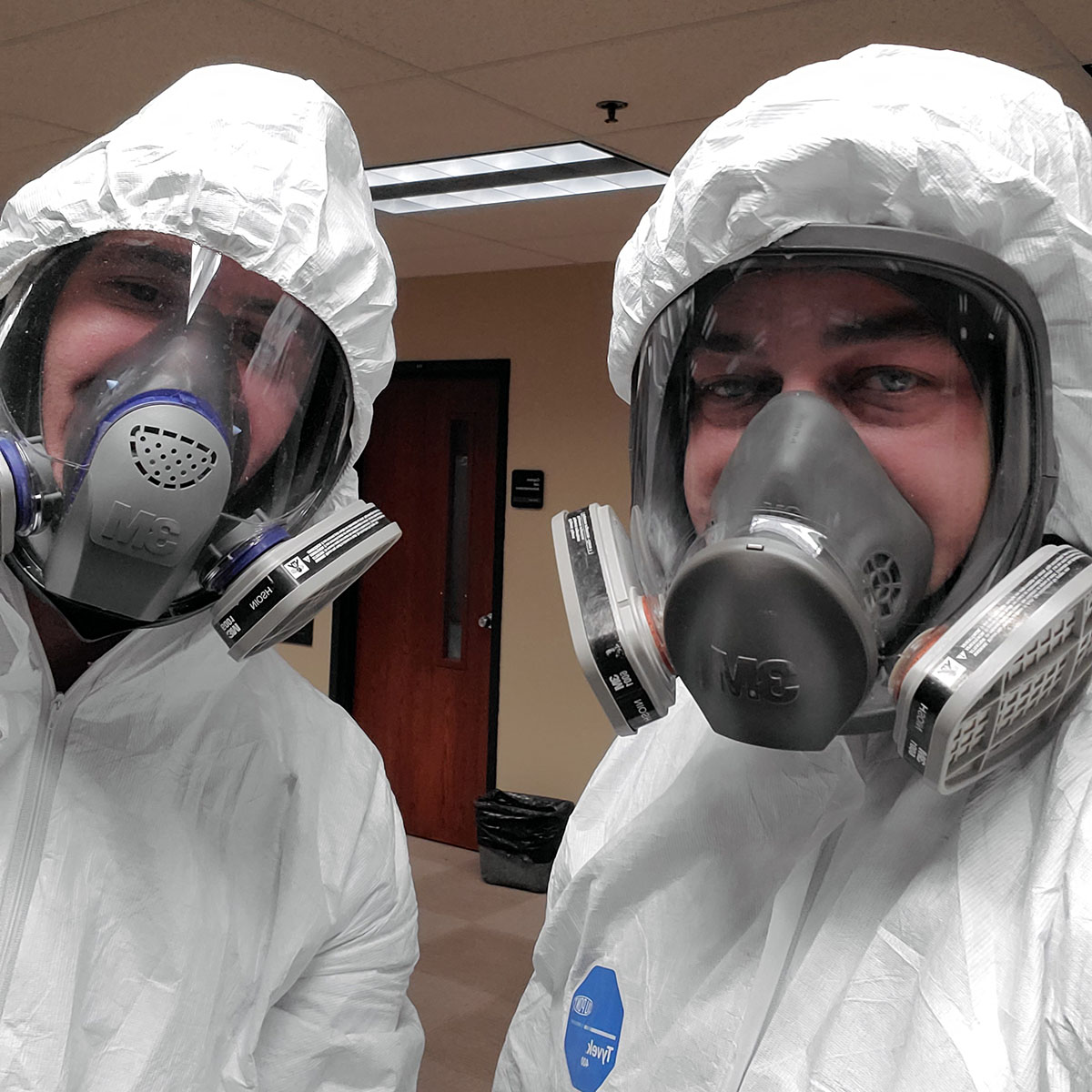Biohazard Removal: Safe Handling and Disposal of Hazardous Products
Wiki Article
Specialist Biohazard Cleaning and Decontamination for Blood, Bodily Fluids, and Hazardous Materials
The potential health and wellness threats linked with direct exposure to biohazards underscore the vital requirement for meticulous handling and thorough clean-up. As we browse the complex landscape of biohazard cleaning, recognizing the nuances of laws, conformity, and the customized equipment at play ends up being critical in guaranteeing a complete and safe purification process.
Health And Wellness Threats of Biohazard Exposure
Direct exposure to biohazards postures significant wellness risks that can cause severe consequences for people and communities alike. Biohazards include a vast array of biological compounds, consisting of blood, physical fluids, mold, bacteria, viruses, and various other potentially contagious products. When people enter contact with these biohazards, whether with crashes, incorrect handling, or ecological direct exposure, they face the threat of contracting severe diseases or conditions.Among the key health and wellness threats connected with biohazard direct exposure is the transmission of transmittable conditions. Bloodborne virus such as HIV, hepatitis B and C, and different microorganisms can be existing in biohazardous products, positioning a straight danger to human health. Inhaling airborne biohazards like mold and mildew spores or coming right into call with contaminated surface areas can also cause breathing issues, allergic reactions, and other unfavorable health results.
In addition, biohazard exposure can have long-lasting wellness implications, with some illness materializing years after the initial call (Blood Cleanup). Therefore, it is important to prioritize proper biohazard cleaning and purification to minimize these health and wellness dangers and ensure the safety of individuals and areas

Specialized Educating for Biohazard Clean-up
When it comes to handling biohazard cleaning efficiently and securely, specialized training plays a fundamental function in making certain appropriate decontamination treatments are followed. Biohazard cleaning calls for certain expertise and skills to efficiently mitigate risks linked with bloodborne virus, bodily liquids, and dangerous materials. Experts trained in biohazard cleaning undertake rigorous instruction on exactly how to safely manage, get rid of, and throw away biohazardous materials to stop contamination and exposure.Specialized training for biohazard cleanup covers an array of essential subjects, including proper individual protective equipment (PPE) use, bloodborne virus understanding, purification techniques, and contaminated materials disposal methods. People learnt biohazard cleanup are equipped with the needed expertise to analyze contamination degrees, determine prospective dangers, and apply suitable cleaning procedures in conformity with regulative criteria.
Constant training and education are paramount in the field of biohazard cleanup to remain updated on the most recent purification modern technologies, safety and security protocols, and regulations. By purchasing specialized training, biohazard cleanup specialists can efficiently react to emergency situation cleanup situations and protect both public health and the setting.
Value of Proper Decontamination Strategies
Using appropriate decontamination methods is crucial in biohazard cleaning to efficiently eliminate harmful materials and reduce health and wellness risks. Efficient purification not only makes certain the removal of visible traces of blood, bodily liquids, and various other biohazards yet additionally targets unseen microorganisms weblink that may posture major health and wellness hazards otherwise correctly gotten rid of. By complying with rigorous decontamination procedures, trained experts can dramatically decrease the threat of direct exposure to hazardous bacteria, infections, and bacteria that could lead to conditions or infections.Correct decontamination methods involve making use read of specific devices and disinfectants that are particularly made to reduce the effects of biohazards properly. Complete cleaning and sanitation of polluted areas are vital to avoid the spread of virus and make sure a secure atmosphere for occupants. Additionally, the right disposal of biohazardous waste complying with purification treatments is important in stopping contamination of other surfaces or people.

Devices and Devices for Safe Cleanup
The appropriate tools and devices play an essential role in ensuring the effective and safe clean-up of biohazardous products. When taking care of blood, physical fluids, or harmful products, biohazard cleansing experts depend on specialized gear to minimize exposure dangers and thoroughly decontaminate the damaged location. Personal safety devices (PPE) such as gloves, coveralls, masks, and safety glasses are necessary to shield versus straight call with possibly infectious products. Furthermore, biohazard cleaning packages consisting of disinfectants, absorbing materials, and biohazard bags are used to safely dispose and include of polluted products. Blood Cleanup.Advanced cleaning devices like hospital-grade anti-bacterials, HEPA-filtered vacuums, and misting equipments are used to disinfect surfaces and get rid of biohazards efficiently. Specialized tools such as sharps containers and biohazard garbage disposal bins more helpful hints are used to safely handle sharp items and biohazardous waste products. By using the ideal devices and devices, biohazard cleansing professionals can make sure a detailed clean-up process that prioritizes security and lessens wellness risks for both employees and owners of the afflicted space.
Laws and Compliance in Biohazard Cleansing
Correct adherence to laws and compliance requirements is extremely important in biohazard cleansing to make certain the safety and security of both personnel and the atmosphere. Government agencies such as OSHA (Occupational Security and Health Administration) and the EPA (Epa) have actually developed certain standards for biohazard cleaning procedures to decrease health risks and ecological contamination. These policies cover a variety of facets consisting of the handling, transportation, and disposal of biohazardous materials, in addition to the needed training and safety devices needed for employees entailed in the cleaning procedure.Biohazard cleaning business need to remain current with these regulations to guarantee that their operations meet the called for safety criteria. Failing to follow these laws can cause severe effects, including fines, lawful action, and jeopardizing the health of individuals and the environment. By adhering to strict laws and conformity steps, biohazard cleansing firms can effectively minimize dangers and make sure a comprehensive and risk-free cleanup process for all events involved.
Conclusion
In final thought, biohazard cleansing and decontamination need customized training, appropriate techniques, and adherence to laws. Exposure to blood, bodily fluids, and dangerous materials positions considerable health and wellness risks, making it critical to make use of the best tools and devices for safe cleanup. By following strict methods and guidelines, experts can successfully reduce the dangers connected with biohazard direct exposure and make sure the safety and security of both themselves and others.
As we navigate the detailed landscape of biohazard clean-up, understanding the subtleties of laws, conformity, and the specialized equipment at play comes to be critical in making sure a comprehensive and secure purification procedure. (Blood Cleanup)
When it comes to dealing with biohazard cleanup effectively and safely, specialized training plays a basic function in ensuring appropriate purification procedures are adhered to.Utilizing correct purification techniques is critical in biohazard cleanup to successfully minimize and get rid of dangerous products wellness threats. In addition, biohazard cleaning kits including disinfectants, absorbing products, and biohazard bags are utilized to safely dispose and consist of of contaminated products.
Federal government firms such as OSHA (Occupational Safety And Security and Wellness Management) and the EPA (Environmental Security Agency) have established particular guidelines for biohazard clean-up procedures to reduce health and wellness threats and ecological contamination.
Report this wiki page